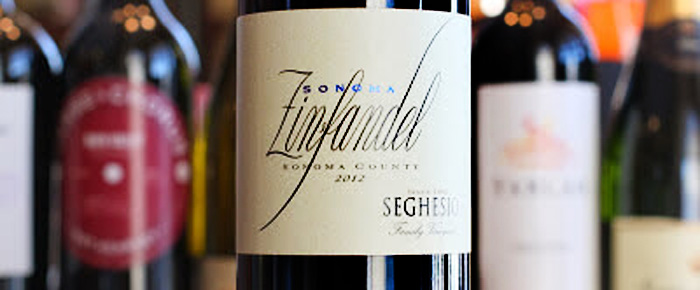
By Rick Riozza
At haste it seems, we continue to cover the comforting red wines of the season before our desert heats again and we seek out thirst-quenching white wine. And as true Californians, we certainly wish to pay homage to two of our “native” grapes that have been producing wine in this state for over the past 150 years.
Yep—that’s right. Just step up and grab a full-bodied, full-on, powerhouse of a wine of either Zinfandel or Petite Sirah. Both wines can offer lip-smacking intensity and concentration of expressive dark fruits that can meet up with any pepper steak or rack of grilled and charred meats lathered with sweet & spicy sauces. Purple-stained Winemakers just love to maintain that bombast vino profile and simply revel in allowing their juice extended contact with the red grape skins, giving the wine its strong tannins and complex flavors.
Zinfandel wine grapes may have arrived in America around 1820 and soon became a popular table & wine grape. Zinfandel then made its way west when the Gold Rush affected national history. It was the wine of the pioneers and millions of gallons were being stored in San Francisco for bottling. By the close of the 19th century, Zinfandel grapes were being planted all over California. Some of these “old vines” still exist today and produce wine that can readily be found in most stores.
Zinfandel wine exudes ripe, red and black fruits including raspberries, blackberries jammy black & red cherries, strawberries and red plums along with spice, pepper and jam characteristics.
Recently, I had the real pleasure of attending the Westin Mission Hills Resort’s winemaker dinners where Restaurant Director Jason Brock provided the culinary coup by featuring the wines of the Seghesio Family Vineyards paired with the stellar cuisine of Chef Joel Delmond and his staff. It was an exquisite evening of wine, food, and company.
In many ways the story of Seghesio Family Vineyards is the story of the Sonoma County wine industry. Through five generations and 120 years, the Seghesio Family Vineyards has been proud to be part of the vibrant history and fabric of Sonoma County. And, Seghesio Family Vineyards is nearly synonymous with Zinfandel, and has been so ever since founder Edoardo Seghesio planted his first Zinfandel vines in Sonoma County’s Alexander Valley in 1895.
Anyone wishing to sample and educate themselves with a variety of Sonoma Zin styles will wish to hone in on the Seghesio portfolio which contains13 different labels! From “old vines” to vineyard specific such as Cortina and Maffei, the line-up is an amazing selection.
Petite Sirah, like Zinfandel, is one of the few wines that California has taken to itself and produced something special. Also known as Durif, and originally from France (it’s the French love child between its royal father, the Syrah grape, and the wayward Country-French gal of a vine, Peloursin) this grape with a feminine name really produces a wine quite on the brawny side with deep rich aromas and flavors of blueberry, blackberry, spice, chocolate, mixed with black pepper notes, licorice, smoked meats and tar.
And there’s a real following among us Californians who just go crazy over this stuff. It’s what a red wine drinker desires when meeting up with a large pepper steak & potato.
It’s historically big and powerful but, a fine bottle of Petite Sirah can also show an elegance like we find in a Cabernet Sauvignon. It has those great mouth grabbing tannins and is somewhat high in acidity that works to make it a wine with the ability to age. Mark Oldman, in his “Brave New World of Wine” calls Petite Sirah “dark and intense as a dominatrix’s boot.” Producer Villa San-Juliette in Paso Robles, calls it “blueberry motor oil”.
Feminine in stylishness, masculine in clout. “Voluptuous” definitely comes to mind—which could be translated as a sexy wine. It’s a winner of a red wine and the trend is to produce the best it can be.
For a number of years in California, Petite Sirah was primarily used as a blending grape, thanks to its deep color and heavy tannins. And it is still frequently blended into Zinfandel for added complexity, body, and to tone down the tendency of Zins toward “jammy” fruit. The famed Ridge Vineyard’s Zinfandel out of Santa Cruz will always have a nice dose of Petite.
Those of us back in the day who enjoyed Gallo’s Hearty Burgundy, really were enjoying a good portion of Zinfandel and Petite Sirah—it was tasty and inexpensive. (I don’t recommend it now—it’s not the same blend).
So many wine enthusiasts remember their first great bottle of a single-vineyard Petite Sirah because there is so much going on with the wine and the synergy of the food pairing. Of course enjoying a glass of the Petite on its own is a treat as well—the wine’s complexities and popping dark-fruit flavors make it a lovely tasting affair.
I definitely have my favorite Petite bottlings through the years that include Stag’s Leap Winery, Puccioni, Biale, Carlisle, and others that can demand higher prices from $25 to $50. The good news I have for you readers right now, is that you can enjoy a great bottle for only $17 plus change at Total Wine & More. The 2014 Line Shack Petite Sirah, from San Antonio Valley AVA, Monterey County, is an amazing value for the quality of this fairly new Petite on the market.
It’s full of ripe flavors and balanced with deep dark color and a flood of plum, dark cherry, blueberry, pomegranate and aromas of mocha, vanilla and oak spice with medium to heavy tannins and a nice long lingering finish. Think of pairing this with hearty red pasta dishes, pizza and spicy Thai. Here’s to deep purple! Cheers!










































